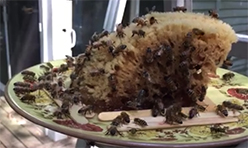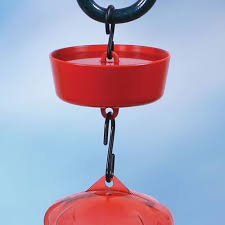|
|
|
|
|
|
When you put out sunflower seeds in the winter to attract Northern Cardinals and Purple Finches, you're bound to also get squirrels. By the same token, putting out hummingbird feeders loaded with energy-rich sugar water is likely to bring other animals that, like Ruby-throated Hummingbirds--are attracted to nectar. We can't legislate animal behavior, so we should learn to live with bees and ants and other invaders that sometimes come to our hummingbird feeders. If nothing else, we humans should be smart enough to outwit insects, and there ARE ways to safely deter them, as described below.
NOTE: Under no circumstance should insecticides or other poisons be used at hummingbird feeders; if they kill insects, these chemicals can't be good for tiny hummingbirds--or people! Any chemical that contains petrochemicals should be avoided; this includes many insect repellents such as Off!, Skin-So-Soft, and 6-12 that might be bumped by a hummingbird and ingested later when it is preening its feathers. Other petrochemicals such as Vaseline and Mentolatum must also be avoided, lest these sticky compounds mat down a hummingbird's feathers; this can cause hypothermia or prevent the hummer from flying.
|
© Bill Hilton Jr. |
Honeybees can be especially pesky on feeders with flat feeding ports because their mouth parts can easily reach the sugar water. Feeders with "bee guards" may work better at deterring these insects, but some hummingbirds don't like them, either. |
HONEYBEES are usually a transient problem at hummingbird feeders. They typically come to artificial sugar water only when there has been little rain and or when there are not many flowers blooming. They seem to prefer feeders in direct sunlight, so hanging a second feeder in the shade often will allow hummingbirds to feed unmolested by bees.

© Bill Hilton Jr.
If honeybees continue to be a problem, mix up a super-concentrated sugar water mix (two parts water, one part sugar) and pour it into a very shallow plate--preferably a big yellow one. Place a large natural marine sponge in the middle (see photo above) so the bees won't drown and to keep hummers from falling in. (DON'T use a synthetic sponge; these are usually impregnated with mold-reducing chemicals that may harm hummingbirds.) Put the plate on a ladder or stool near the hummingbird feeder the bees are using and they will probably move over to the plate. Each day, move the plate a foot or two further away from the hummingbird feeder and eventually the bees should stop using the feeder. (NOTE: Were you aware that Honeybees, Apis mellifera, are an INTRODUCED, non-native insect brought to this country by early settlers to produce honey?)
YELLOW JACKETS, WHITE-FACED HORNETS, PAPER WASPS, and other stinging insects sometimes take over a feeder and even drive away hummingbirds from them. In this case, discretion may be the better part of valor; let the insects have the feeder and put up other feeders where the hummingbirds can find them. These stinging insects, some of which are mostly carnivorous, can often be lured away from hummingbird feeders by putting out a plate with a small lump of hamburger meat saturated with apple juice.

Image courtesy Duncraft
ANTS also sometimes infest hummingbird feeders. No matter what you do, they seem to eventually be able to get to any feeder. To deter them you can buy "ant traps," which are devices that hang above the feeder and--when filled with plain water--form a moat that keeps smaller ants from getting to the sugar water. Larger ants often dive right into the moat, however. Some folks have success with using very fine fishing line (monofilament) to hang the hummingbird feeder; it may be too smooth for the ants to climb, but be sure it's strong enough to hold up the feeder. (NOTE: You can make your own ant moat from the lid of a spray paint can and a length of stiff wire. Stick the wire through the lid, seal around the wire with waterproof glue, and bend the wire ends to create hooks.)
Remember that leaky, dripping hummingbird feeders attract many more bees and ants than those that are properly maintained. Furthermore, old, fermented sugar water may more likely to attract insects than hummingbirds, so be sure to change the mix at least twice a week in warm weather if the hummingbirds don't drain it.
ENVIRONMENTAL COMMENT: Unlike many introduced pests--Japanese Beetles and Kudzu, for example--Yellow Jackets are native insects that were here long before people started feeding sugar water to hummingbirds. We realize that many folks are allergic to insect stings, but that doesn't give us the privilege of eradicating these beneficial six-legged animals from the environment when we have offered artificial food that actually attracts hummingbirds AND other nectar-loving creatures.
Since Yellow Jackets are attracted to nectar, one might assume they are important pollinators, and for them and many species of wasps that is indeed the case. In these days of rampant insecticide use, we humans have nearly eliminated many solitary bees and other native insects that ARE important pollinators of wildflowers, trees, and shrubs. Yellow Jackets seem a little less sensitive to this assault and should be tolerated as they go about their business of pollinating. Incidentally, Yellow Jackets also protect agricultural crops by killing large numbers of caterpillars and even some adult insects they then feed to their larvae.
RACCOONS and OPOSSUMS sometimes acquire a taste for sugar water in hummingbird feeders and will pop off the fake plastic flowers to gain access. For an interesting solution to this problem, please see our Web site for Hilton Pond Center for Piedmont Natural History, specifically at This Week at Hilton Pond for 15-21 May 2008. If bears start robbing your artifical nectar, by all means bring the feeders indoors for a few days until the big carnivores move on.
Back to Feeders
Back to Hummingbird Feeding Hints
Up to Top of Page
On to Hummingbird Habitats
|
Make direct donations on-line through
Network for Good: |
 |
|
LIKE TO SHOP ON-LINE?
Donate a portion of your purchase price from 500+ top on-line stores via iGive: |
|
|
Use your PayPal account
to make direct donations: |
|
|
|
Share Your Hummingbird Experiences Through "Hummingbird Hobnob" |
 |
Operation |
|
|